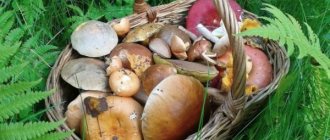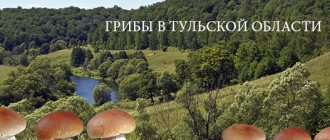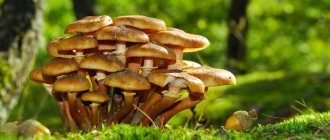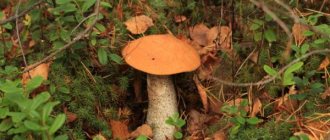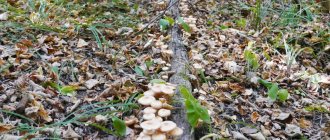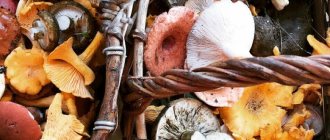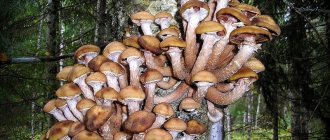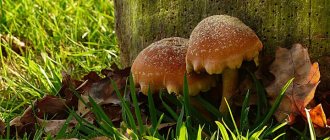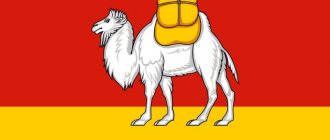Of course, it’s easier to go to the market and buy as many champignons as you can carry. After all, these mushrooms are on sale all year round. Because they reproduce well in captivity, so to speak about mushrooms...
After all, champignons are very prolific mushrooms. The plates of one mushroom contain up to sixteen billion spores, each of which can give birth to a new mycelium.
But these common mushrooms are not only edible, but also healthy.
- Fresh mushrooms contain 4.88% proteins, 1.11% carbohydrates. They also contain potassium, sulfur, phosphorus, magnesium, sodium, calcium, and chlorine.
- Mushrooms contain a lot of vitamins D and PP, and also contain vitamins B1, B2, B3, B6, B12, A and C.
- Champignons contain enzymes that break down proteins, fats and carbohydrates, thanks to which food is better absorbed.
- Champignons are used in dietary nutrition due to their low calorie content.
- The non-toxic antibiotic compestrin was found in champignon, which has an inhibitory effect on typhoid bacilli and Staphylococcus aureus.
Mushrooms of the Volgograd region
We invite lovers of “silent hunting” to take a walk through the mushroom places!
The Riverside Park Hotel is always waiting for those who want to enjoy a walk through the oak grove in search of a variety of mushrooms. We welcome both beginners and avid mushroom pickers who want to shed the negativity of the city and get an unforgettable experience and positive emotions. Kalachevsky district, Ryumino-Krasnoyarsky farm is an attractive territory for hunters of tasty and healthy mushrooms. Landscapes change, providing the opportunity to choose your favorite type of forest product, and the unique ecosystem where the park hotel is located is attractive at any time of the year. Spring varieties of forest gifts. One of the earliest mushrooms waiting for mushroom pickers are chanterelles . It is difficult to confuse healing red mushrooms with other varieties - they peek out here and there as bright islands from the green May and June grass. They grow in whole families, the colors vary from light yellow to bright orange. The caps are fleshy, with wavy edges and pressed into the center. The only type of non-fragile mushrooms, thanks to which they can be carried in backpacks and bags. Chanterelles love spruce and deciduous forests. Another variety of spring mushrooms are dung beetles . Collection time is from May to October; it loves soil rich in organic remains and fertilizers, rotting trees, stumps, and compost pits. Important! Not all of the dung beetles are edible; the variety is classified as conditionally edible - only young mushrooms can be eaten while the plates are still white. If they begin to turn yellow or pink, the mushroom is no longer suitable. They can also cause food poisoning if consumed simultaneously with alcohol. The variety has a special appearance, which is why it is often mistaken for a toadstool - the elongated, ovoid cap eventually becomes bell-like, and is abundantly covered with scales on top. Despite the name, dung beetles are very tasty, but they cannot be stored for future use and must be consumed as soon as possible after collection. In damp spring weather, morels . It’s hard to ignore their unusual shape – ovoid and pointed caps on conical legs, not very attractive in appearance. They grow everywhere - forests, meadows, ravines, even parks! As soon as the snow melts and the spring sun appears, they are already here. They love places where there was previously a fire or fireplace. Before cooking, you need to boil for 5-7 minutes and drain the water, after which you can fry, boil and simmer. Morels baked in the oven in sour cream are especially fragrant. From the beginning of May until the end of autumn, tinder fungi . You don’t have to bend over for them - they grow right on tree trunks, branches, stumps, and fallen trunks. For the most part, these unusual-looking mushrooms look like growths on the bark - massive caps of various colors rest on strong legs, which are located on the side and are almost invisible. It is recommended to collect during the spring sap flow and in the fall, when the mushroom stores useful substances for wintering.
The beginning of the summer season. Since June, more mushrooms appear, and there are varieties for every taste. White is deservedly called the “king of mushrooms,” and every mushroom picker wants to see it in his basket. It has a piquant taste and a truly mushroom aroma, and its flesh remains white regardless of the chosen cooking method - it does not mind boiling, frying, stewing and drying. The young mushroom has a hemispherical cap, which becomes cushion-convex with age. Its color depends on the forest where the mushroom grows. In oak, for example, it will be white, almost pale. Maturity is determined by the color of the tubes under the cap - if they are yellowish, then the mushroom is ready for harvesting. Some specimens can amaze with their size, because the diameter reaches 40 cm. It’s interesting to look for white varieties: if you find one, look around, there are definitely brothers hidden somewhere. Borovik is a good family man, there are practically no loners among the variety, unless someone has already visited it before. At the end of the first summer month, champignons . They grow in spruce forests and oak groves, in pastures and fields. The variety has a fleshy and dense cap, sometimes with a brown or brown tint. Young mushrooms have a rounded cap, becoming flatter over time. Young mushrooms are more in demand for eating, as they have an excellent taste. Excellent for canning, pickling and pickling. Champignons are considered the most common not only in the region, but throughout the world. In free areas of forests - meadows, clearings, edges - umbrellas . Their hats, initially spherical, gradually open up, becoming like an umbrella. They are distinguished by their large sizes - up to 25 cm in cap diameter and up to 20-30 cm in stem height. Young mushrooms are edible, they are fried and boiled, and the strong mushroom aroma will not leave anyone indifferent.
July and August mushrooms. In the second half of the summer season, you can come to the Volgograd region for other representatives of forest inhabitants. Moss fly is taken from the beginning of July to the end of August. Many people deny this mushroom its beneficial properties and do not collect it, leaving it to grow further. At the same time, stewed flywheel pulp can be compared to porcini mushroom - the main thing is to know how to cook! It is also boiled, fried, pickled, but dried extremely rarely. Small specimens are collected; the flesh turns blue when cut or broken. As the name implies, this mushroom loves to grow among mosses. Milk mushrooms were named so because they grow in families, “piles”. They are found from July to October, preferring birch and mixed forests. In the Volgograd region they are often found in the area of the village of Trekhostrovskaya, Lebyazhya Polyana and Kalach-on-Don. They have a wide cap, almost flat on young mushrooms and funnel-shaped on older ones. Milk mushrooms hide under leaves that stick to a slightly slimy surface, so mushroom pickers have to look for them rather than just go and pick them. Therefore, it turns out to be a real “silent hunt”; a person gets real pleasure from such a walk. Valuy , also known as goby, snotty and kulak, found in large groups Young mushrooms, just suitable for picking, resemble a fist-shaped cap, ocher-yellow or yellow-brown. After boiling, it is suitable for pickling and salting. Grows in coniferous and deciduous forests from July to late autumn. Russulas , are not afraid of the vagaries of the weather . These mushrooms got their name because when pickled they become ready (and very tasty) very quickly, sometimes within a day. The variety of colors of russula is amazing - gray, dark red, yellow, purple, green. The latter are considered the most delicious in the russula family. Ryadovka in the Volgograd region is represented by two varieties. The peak collection of poplar row occurs in August, and the name itself suggests where it is best to look for it - among the poplars. Semicircular brown caps sit tightly on strong cylindrical legs. The mushroom grows, increasing the cap in size - first hemispherical, then convex, later becoming flat. Red-brown mushrooms are mixed with potatoes, fried and enjoyed for their special taste.
Autumn season. The Volgograd region will delight forest lovers in the fall, because after the rains, mushrooms appear from the ground, like in a fairy tale. From late August to late autumn, the stumps of honey mushrooms . From a distance it may even seem that these are not mushrooms, but a light brown growth. They prefer stumps and roots of living and fallen trees, preferring old birch trees, less often other deciduous trees. In the Volgograd region, it is distributed in the Shakinsky oak grove, the village of Surovikino and Kalache-on-Don. The caps of young honey mushrooms look like balls cut in half with edges curved inward, then flat-convex with a tubercle in the center. The surface is dry, yellowish or brown, with thin scales. Young caps are usually cut off for food. The dense white flesh crunches appetizingly when simmered in a frying pan. Oyster mushrooms also love to grow on stumps, as well as on dead wood or weakened aspens, birches, rowan trees and oaks. The short stem turns into an asymmetrical gray funnel-shaped cap. The pulp of the mushroom is light and juicy, has a pleasant aroma and taste. Oyster mushrooms are dried, salted and pickled, added to hot dishes, and you can find them right up until December. Greenfinch is the second type of rowing. It differs from poplar in its greenish-yellow color, for which it got its name. Mass collection occurs in September-October and is often found in the forests of the Kalachevsky district. The cap is flat and semicircular, changing color from yellow to green. Its structure is very sticky and consists of small scales. The white pulp has a distinct mushroom aroma. When cooked, the greenish tint intensifies; greenfinches are also boiled, fried, pickled, and, less often, salted.
Poisonous
In the wide expanses of the Volgograd region, in addition to edible mushrooms, you can often come across poisonous ones, the consumption of which in food in any form can lead to serious consequences for the human body. Therefore, when collecting mushrooms, it is better to ignore unfamiliar representatives of this kingdom. The most common poisonous mushrooms found in the Volgograd region are worth considering in more detail.
fly agaric
Description. Fly agarics are known to many people as extremely poisonous mushrooms. A common species is the red fly agaric. The diameter of its cap can reach up to 20 cm. It has a bright red color, on which white spots are scattered. Such mushrooms are visible from afar and are difficult to confuse with others. Aged mushrooms may not have white spots. The leg of the red fly agaric is thin and long, has a cylindrical shape, and is completely white. Often a flat or slightly torn ring is noticeable on the stem.
Where and when does it grow? Red fly agaric grows near birch and spruce trees on acidic soils. Appears in August, disappears in October.
Varieties. There are many types of fly agarics, some of them are edible. But you should not experiment with such mushrooms; their poisonous species are quite common in our forests. In addition to the poisonous red variety, there is the toadstool fly agaric. Its cap is slightly smaller in diameter, the color is not so bright - it can be gray-yellow or dirty white. It is found more often on sandy soils.
Doubles. The red fly agaric has hardly any counterparts. Champignons can sometimes be confused with toadstools or toadstools due to their white caps and similar shape.
Satanic mushroom
Description . Belongs to the Boletaceae family. The Satanic mushroom has a stem that is brighter than its cap. Its color changes from top to bottom from yellowish-red to brown-yellow through orange-red. There is a mesh pattern on the surface of the leg. Its shape is unusual: at first it is ovoid or spherical, then it becomes barrel-shaped. The cap is white, gray or off-white, maybe with an olive, yellow or yellow-brown tint. Shaped like a hemisphere or a pillow. In a ripe mushroom it is spread out, the skin is smooth or velvety. The flesh of the mushroom turns blue after cutting.
Where and when does it grow? The mushroom grows in light forests where there is oak, beech, hornbeam, hazel, and linden. Prefers limestone soils. Found from June to September.
Varieties. Varieties of the satanic mushroom include other mushrooms of the Boletaceae family with bluish flesh and colored pores.
Doubles. The satanic mushroom can be confused by external signs with a gall or porcini mushroom.
False champignon
Description. This mushroom is very similar to a regular champignon. This poisonous mushroom can be distinguished from the latter by its unpleasant smell. There is also a poisonous fellow similar to champignons, which has a yellowish or red color. False mushrooms can be easily identified by their pulp, which does not change color when pressed, unlike the pulp of edible mushrooms.
Where and when does it grow? False champignons are found mostly in coniferous and mixed forests, but sometimes you can find them in the garden, field, and yard. They grow over several months - from May to November.
Varieties. Of the poisonous species, the ones most often found in our forests are variegated and yellow-skinned champignons.
Doubles . Ordinary champignons are often confused with toadstools.
Common puffball
Description . The fruiting body of the false puffball has an ovoid, spherical or slightly flattened shape, about 5-8 cm in diameter; this mushroom does not have a stalk. Before its full maturity, the false raincoat can be completely immersed in the ground. The color of mushrooms is often light or grayish. As the mushroom matures, characteristic cracks are visible on the fruiting body.
Where and when does it grow? Common puffballs grow in coniferous and deciduous forests. They are found on the edges and along roads. They settle on loamy and clayey soil. These mushrooms bear fruit from August to September. Spotted puffballs are found in any forest. The main conditions for them are moist soil and good light.
Varieties. In addition to the common puffball, there are also spotted, panther, and warty puffballs.
Doubles. As the name of the mushroom itself suggests, it is very similar to an ordinary raincoat.
Bile mushroom
Description. Gall mushroom is inedible due to its bitter taste, which is enhanced by cooking. The diameter of the mushroom cap rarely exceeds 10 cm; it has a hemispherical shape at the beginning of growth, later becoming more flattened. In terms of color, the cap is often yellow-gray, less often brown or darker. The stem is of medium length and thickness, cylindrical or club-shaped, and resembles a cap in color.
Where and when does it grow? The gall fungus is widespread in many coniferous and deciduous forests. You can find one mushroom or a small cluster of them at the base of a tree, on a rotten stump. Grows from June to October.
Varieties . Sometimes there is a type of gall mushroom, the pulp of which, when raw, has a pleasant taste, but when cooked, the bitterness is still released.
Doubles . At the beginning of growth, the gall mushroom is similar to porcini mushrooms and other boletus mushrooms; sometimes it can be confused with boletus mushroom. The difference from the latter will be the absence of scales on the stem, from boletus - the presence of a dark mesh.
Death cap
Description. Pale toadstool belongs to the fly agaric family and is considered by many people to be the most poisonous mushroom. The average diameter of the cap is 10 cm; initially it has a spherical shape, over time it stretches and opens until it becomes flat. The edges of the cap are smooth, fibrous, and its color varies from white to greenish-gray. The stem of the mushroom is long, about 12 cm, and thin, about 2 cm. It has a cylindrical shape and thickens at the bottom, similar in color to the cap.
Where and when does it grow? Often the pale grebe is found on fertile soil under deciduous trees such as hazel, oak, and beech. This mushroom is characteristic of coniferous and deciduous forests. Its growth peaks at the end of summer and beginning of autumn.
Varieties. The pallid grebe itself is a species of fly agaric, so this entire family can be called its variety.
Doubles . By inexperienced mushroom pickers, toadstool may be collected instead of desirable edible mushrooms such as champignons, green russulas and floats.
Forest plantations in the Volgograd region
The weather in the Volgograd region is mostly clear and dry, which is not surprising in a very dry climate, so weathering of the topsoil is a real disaster for farmland.
Today, 400 hectares of forests grow in the region in natural conditions along the banks of the Volga, Don, Khopra rivers and in ravines. Floodplain forests of the Volgograd region are mainly represented by oak, black poplar and trees and shrubs.
In addition, over the past 60 years, work has been carried out on artificial planting of forests, the function of which was to protect fields from dry winds. Not all of them were successful, since the composition of the soil and the species of trees and shrubs suitable for it were not always taken into account.
But there were also positive results, thanks to which today there are more than 200,000 hectares of artificial green areas in the region, some of which protect the soil from erosion, and some of which are recreational areas for the local population.
Are mushrooms a threat to life?
In terms of the number of sunny days per year, warm spring and hot summer, these places are similar to Crimea, although short and cold winters remind us that this is the southeast of the Russian Plain. In summer, temperatures reach 38-45°C, thanks to masses of hot air from Kazakhstan, and there is an acute lack of precipitation.
Although the summer weather in the Volgograd region is dry, thanks to new forests people have the opportunity to collect mushrooms. The only problem they may have is the risk that in the absence of rain, even edible mushrooms can pose a danger to life.
This is due to their accumulation of toxic substances during the drought period, therefore, as soon as the rain passes and they appear en masse from the ground or on tree trunks, some of them can become as poisonous as toadstools or fly agaric mushrooms.
Edible mushrooms in the Volgograd region should be collected very carefully and only with knowledge of this matter or accompanied by experienced mushroom pickers who recognize the danger.
The mushroom picking championship held in the region encourages people to “quietly hunt”, which, in turn, obliges its participants to understand them well. This gambling competition increases the number of professional mushroom pickers among the local population.
Spring mushrooms
Edible mushrooms of the Volgograd region can be divided according to the time of collection into spring, summer and autumn species, so the most passionate “hunters” devote the entire warm season to their favorite activity. So, in the spring mushroom pickers can expect:
- Chanterelles are easy to spot in young May grass due to their light yellow to orange color. They appear first and, as it were, open the “hunting” season. Chanterelles are difficult to confuse with other mushrooms, as they have large caps with wavy edges, slightly depressed in the middle. They can be found both in pine-spruce and deciduous forests, which grow in the Uryupinsky, Olkhovsky and Chernyshkovsky regions.
- Following the chanterelles, dung mushrooms emerge from the ground. Depending on their age, they may have a white cap (young), pink (mature) or black (old). Only young mushrooms are suitable for food, they are meaty and very tasty, but you won’t be able to prepare them for future use. Harvesting should be done in May near compost pits, in fields and near vegetable gardens. Most often found in Surovikinsky, Chernyshkovsky and Alekseevsky districts.
- Boletus mushrooms also appear in May, when the whole earth begins to turn green and bloom. They are easy to distinguish among the grass, since they have wide yellow-brown or reddish caps, firmly sitting on a cylindrical stem, which as they grow can stretch up to 20 cm in height. Boletus mushrooms are found in the aspen forests of the Kletsky district.
Knowing the schedule of each species, you can plan a route in advance and go to where mushrooms are picked in the Volgograd region in May.
Mushrooms in early summer
If the summer is not too dry, then the entire Volgograd region becomes a mushroom harvesting site. Mushrooms grow en masse at this time, so both experienced mushroom pickers and ordinary amateurs come to buy them. The latter, unfortunately, sometimes become victims of their inexperience and greed. As regional doctors note, most of the patients who came to them with signs of poisoning either mistakenly ate poisonous mushrooms or incorrectly prepared edible ones.
Therefore, before eating them, you should study the mushrooms of the Volgograd region. Edible and poisonous are often very similar to each other, and if in doubt, it is better not to cook them at all. In the first half of summer, mushroom pickers can expect:
- Porcini mushrooms that appear in early June. They are easily recognized by their large cap, which in some specimens can reach 40 cm in diameter. When the tubes of a porcini mushroom under the cap become olive or yellowish in color, it means it is mature and can be eaten. The color of the porcini mushroom cap varies from light brown to reddish-brown, and the stem can be up to 25 cm in diameter. They grow en masse in oak, birch and pine forests of the Kumylzhensky, Alekseevsky and Gorodishchensky districts.
- Champignons await their harvest at the end of June. This is the most common species that delights mushroom pickers in the Volgograd region. Champignon mushrooms have excellent taste and are found not only in spruce forests, but also in meadows, pastures, in the Shakinsky oak grove and in the “Tsimlyansky Sands” of the Chernyshkovsky district.
- The end of June and July is a favorable time for boletus, which most often grows in the pine forests of the Rudnyansky, Novoanninsky, Olkhovsky and Zhirnovsky districts.
Less common is the giant raincoat, which, by the way, you should be careful with. It is edible only in white color, so if you encounter a brown specimen, you should avoid it.
Forum - latest news, what do they write?
Communication on city forums is becoming increasingly popular among mushroom pickers. There they discuss their favorite hobby, compare this year’s harvest with previous ones, and most importantly, share landmarks of the area where they have repeatedly found mushrooms.
In 2022, the list of mushroom places included:
- a village located near the city with the beautiful name “Rudnya”; territory of Lebyazhya Polyana;
- the vicinity of the Gorodishchensky district, near the village of Panshino;
- in search of porcini mushrooms, it is recommended to go only to the area of two oak forests: Kumyzhenskaya and Shakinskaya;
- pine honey mushrooms, boletus and umbrellas can be found on the outskirts of the Chernyshevsky district, famous for its rich and beautiful “green” place - the Tsimlyansky forest;
- You shouldn’t bypass oak forests and farmsteads. Despite the local population living nearby, there are enough mushrooms in the Ryabovskaya and Shakinskaya oak groves for all guests.
What mushroom pickers collect in July and August
The second half of summer is not a reason to sit at home, as this period welcomes mushroom lovers with very interesting representatives:
- Milk mushrooms are large mushrooms with a cap in the middle of which there is a funnel. They are hard to miss. Although the Volgograd region is rich in mushroom harvest, these mushrooms should be collected when they are at the ripe stage. And when rusty spots appear on the light cap of a milk mushroom, it is better not to touch them. They are found in the pine, birch and aspen forests of the Trekhostrovskaya village, on Lebyazhya Polyana.
- In August, mushroom pickers will find moss mushrooms that grow in the mosses of pine forests near the village of Kletskaya. They have brown caps, which make it easy to determine their age - cracks indicate that the mushroom is mature. You can determine that it is a moss fly by looking at the cut of the flesh, as it is blue.
Processing oil after collection
This type of mushroom is suitable for any method of culinary processing. They are boiled, fried, baked, canned for the winter, dried, frozen. The most delicious are young autumn specimens. Before cooking, they need to be peeled, washed and the brown skin removed from the cap. Otherwise, it will ruin the whole appearance of the dish with its dye. If the skin is difficult to remove, you should soak the mushrooms in boiling water for a couple of minutes and then pour cold water over them.
Important! Mushrooms should be cleaned and processed immediately after picking, using gloves. Otherwise, the dye from the skin on the cap is difficult to wash off your hands.
Autumn mushrooms
In autumn, mushroom pickers are limited to the small number of species offered by the Volgograd region. Mushrooms appearing in late August and September:
- Poplar row (podtopolnik). It has a semicircular cap of a brown or reddish hue, firmly sitting on a cylindrical stem. Found in forests dominated by poplars. In the Volgograd region these are Svetloyarsky, Olkhovsky, Rudnyansky districts.
- Autumn honey mushrooms, which can be found in large numbers on stumps and tree trunks, mainly on birch trees in the Shakinsky oak grove, Chernyshkovsky and Surovikinsky regions.
- Greenfinches are tasty yellowish mushrooms with a semicircular cap on young ones and flat on mature species. They grow in the pine forests of the Kalachevsky district.
This is the harvest the Volgograd region offers to mushroom pickers. Mushrooms grow in almost all forest belts of the region, but there are special places that every lover of quiet hunting knows. and in May.
Poisonous mushrooms of the Volgograd region
The greatest danger for novice mushroom pickers is false champignons. They can be distinguished from real ones only by their unpleasant smell, since the change in cut color from grayish to yellow alarms few people.
Fly agarics and toadstools are rare, but ignorance of the expiration dates of edible mushrooms can also lead to poisoning.
For example, tinder fungi, which are often found on tree trunks, are edible only when young, and only an experienced mushroom picker can determine their age.
Reviews from mushroom pickers on VKontakte
If you believe the reviews of mushroom pickers on forums and in the relevant groups, thanks to the impressive size of the forest area in this region, there is a good chance of finding trophies that are rare for Volgograd. If we talk about common ones, then experienced mushroom pickers distinguish:
- Honey mushrooms;
- Greenfinches;
- Milk mushrooms;
- Green Flywheels;
- White mushrooms;
- Chanterelles;
- Rows;
- Champignon.
- There are also dung beetles, as well as boletus, puffballs, boletus, and umbrellas. The latter are valuable for most mushroom pickers along with Porcini Mushrooms and Champignons.
How to distinguish a poisonous mushroom from an edible one?
Popular
Money month: which zodiac signs will be lucky with finances at the end of November
Astrologers named the zodiac signs with the most ancient souls
Astrologers named the zodiac signs that will experience changes in 2020
A pale, excited man burst into the Department of Biology and Chemistry of VGSPU. He begged for help: he ran all over Volgograd, but couldn’t find a specialist anywhere. His little daughter found some kind of mushroom near the sandbox and ate a good half of it. To treat a child, it was necessary to understand why.
Vasily Dudka was turned around almost at his house. Having turned the remains of the mushroom in his hands and pinched off a piece, the mycologist finally took responsibility: “the mushroom is non-poisonous.” The young father was blown away by the wind, and a week later he came to thank the rare specialist - he turned out to be right.
“Evenings” asked Vasily Dudka to conduct a mushroom educational program for our readers.
? What is preferable: a family of butter in the wild forest or cultivated mushrooms in a store?
– In my opinion, cultivated. They are environmentally cleaner; they are grown on special substrates that are not associated with the environment, that is, cultivated mushrooms do not absorb harmful substances from the environment, like their natural brothers.
? Well, they killed all the mushroom romance. And yet many people are attracted to wild mushrooms. Which of them are most often found in our area, which are the rarest?
– If we talk about edible ones, then these are oyster mushrooms, rows, boletus, white (oak form), milk mushrooms, champignons. Rare - if there is no rain - boletus and boletus.
? Are boletuses called that because they grow strictly under aspen trees?
– No, there is oak boletus, spruce boletus, pine boletus, many of the aspen boletuses have a connection with birch.
? Under the same aspen, the boletuses are multi-colored: sometimes orange, sometimes red, sometimes very yellow, and the color becomes more and more saturated in the fall. Does it depend on the maturation of the mycelium?
– It depends on how much the mycelium gave the mushroom nutrients. In dry times the fungi are small and misshapen. The color of the mushroom cap in this case is an indicator of its maturity and moisture saturation.
? What is the calendar time frame for the appearance of a particular mushroom? What are the latest mushrooms?
– The spring period accounts for 8%, the summer period – 32%, and the autumn period – 60% of the total species diversity of cap mushrooms. The earliest, widespread, but little collected is Strobilurus pine. The late mushroom is the winter honey fungus, it lasts until December, and sometimes later, depending on the weather.
? What places in the Volgograd region have the most mushrooms?
– Each mushroom picker has his own places, but the richest, in my opinion, are the Volga-Akhtuba floodplain, Tsimlyansk sands, Shcherbakovsky natural park, floodplain forests of the Don and Volga rivers. We have a lot of mushrooms - about 1500 species!
? How long do mushrooms take to grow?
– The expression “grow like mushrooms after rain” speaks for itself. The gifts of the forest ripen quickly. A significant factor is the weather - rainy, warm, and so on. Dung beetles, for example, take several hours to grow, while the porcini mushroom can ripen within a month. Milk mushrooms and russula last two to three weeks.
? What is the best way to collect these gifts of nature?
– The ideal option is wicker baskets or wooden boxes, that is, natural packaging. It must be open. It is not advisable to use plastic bags, because the mushrooms in them will quickly dry out and crumble. Plastic buckets are also not suitable, because mushrooms absorb everything like a sponge.
There is no need to store your forest catch for more than a day; the product is perishable. The fact is that a number of proteins decompose, and some decomposition products are toxic to humans.
? That is, any mushroom can become poisonous?
– Anyone, quite a few poisonings have even been recorded with porcini mushrooms. The degeneration of an edible mushroom into a poisonous one may also be due to the fact that the mushroom is located in a substrate containing harmful substances.
? By what signs can you distinguish a poisonous mushroom from an edible one?
– Alas, there are no clear general signs. The safest mushrooms are those that grow on wood, like oyster mushrooms. In our region, the insidious fringed galerina grows. The poisonous mushroom prefers coniferous and mixed forests with a predominance of conifers.
80% of poisonings are associated with the fringed galerina, while the pale grebe accounts for only 5%.
The “Killer” has a slimy-glossy cap, very similar to honey mushroom, so even an experienced mushroom picker often puts it in a basket. A dangerous mushroom can be identified by the presence of a ring on the stem.
About 80 species of champignons are found in the region. Among them there is also a poisonous one - the yellow-skinned champignon. It is sometimes even sold in local markets, confused with its counterparts. A characteristic feature of the yellow-skinned champignon is its yellow color, which appears when the flesh is pressed, as well as an unpleasant odor.
? There has long been a debate about how to properly collect mushrooms - cut or twist?
– Mushrooms that belong to the tubular type (ceps, aspen mushrooms, boletus mushrooms) are mushrooms with one thick stem. It would be more correct to unscrew them. It would probably be better to approach lamellar mushrooms (saffron mushrooms, milk mushrooms, mushrooms) with a knife, because their stems are thin and can crumble when twisted. In general, I am a supporter of twisting. The arguments are as follows: when a person cuts off the stem of a mushroom, an “open wound” remains, through which microorganisms penetrate faster and more easily. The absence of a stem can be confusing. So, if you cut off the leg, the pale toadstool cannot be distinguished from the row.
Most common places
Not everyone who lives in the region knows where to pick mushrooms in the Volgograd region, but those who love them very much have long noted the areas most suitable for picking:
- If you head towards the Don or the Tsimlyansk Reservoir, you can find rows of poplar rows and aspen boletuses in the tracts of pine and deciduous coppices. There are also honey mushrooms here, but so far in small quantities.
- For lovers of milk mushrooms, the best place will be the Volga-Akhtuba floodplain. In addition to these majestic mushrooms, there are rowed mushrooms, a small number of moss mushrooms and Polish porcini mushrooms.
- The Volga Islands are also rich in milk mushrooms and moss mushrooms. Therefore, this direction is also a favorite among many mushroom pickers.
When visiting unplowed areas near the reservoir, where there are pastures and pastures nearby, you can find many mushrooms.
Mushroom places of the region
Among the best places for collecting mushrooms in this region, according to many mushroom pickers, it is worth highlighting the following areas:
- The area of the Tsimlyansk Reservoir , the villages of Panshino and Krasnodonsky, in the direction of the Don. The massifs of deciduous and pine forests, the damp lowlands of these places are rich in a large number of boletus, boletus and boletus.
- Denezhny, Golodny and Sarpinsky Islands . In the moisture-rich lands, fly mushrooms, milk mushrooms, Polish mushrooms and many others grow well here.
- Volga-Akhtuba floodplain, Pokrovka, Gromkov, Zubarevki area . Here you can often find milk mushrooms and rows, but umbrellas are extremely rare due to insufficient humidity for them.
- Steppe area near the Volgograd reservoir . In the vast steppe territories near pastures and pastures, many meadow champignons are concentrated.
As can be seen from the listed diversity, the Volgograd region is of particular value for mushroom pickers. Here you can find a lot of tasty and healthy mushrooms. But with each collection, you need to carefully ensure that no poisonous mushrooms end up in the basket, otherwise this could ultimately create serious health problems.
0
0
Copy link
List of edible mushrooms
Perhaps the region is not so rich in mushroom places, but collection is still carried out. You need to figure out what mushrooms grow in the Volgograd region. There are quite a few edible ones:
- Common champignon. It has a cap, the diameter of which is 6−12 cm. Young mushrooms have a hemispherical shape, a little later it becomes more open. The white leg, if cut off, turns reddish. The mushroom has a pleasant aroma; it is added to soups, as well as fried and stewed vegetables.
- Giant raincoat. This specimen does not have a leg; it has the shape of a ball. The young mushroom has a whitish tint, later acquiring a brownish color. They are collected when they are still white.
- Common oyster mushroom. It is located in the trees. The mushroom caps are slate-gray, smooth with slightly curled edges. Oyster mushrooms grow in large groups and are collected before frost.
- Oil can. This is a mushroom with a fleshy stalk, on which there is a whitish disappearing ring. The hat is yellow-orange in color and feels slimy to the touch. The specimen can be found until October on soils rich in lime.
- Boletus. There are two types: with a red cap and a yellow-brown one. This is a dense mushroom on a thick whitish stalk with scales. Grows in deciduous forests singly or in groups. It is pickled, fried or salted.
- Milk mushroom. A young mushroom has a flat white cap, which with age acquires a depression in the middle part. Its edges are shaggy. The leg is short. The mushroom has a bitter taste, so it is soaked for a long time before salting.
Dangers during collection
Despite the dry weather that prevails in the region, the planting of new forests has allowed mushroom picking to take place. Almost every mushroom picker knows mushroom places in the Volgograd region. However, due to drought, certain dangers may arise. Mushrooms that are considered edible can become unfit for consumption and even poisonous.
The fact is that they accumulate toxic substances during drought . The rainy season becomes a signal for the massive appearance of mushrooms, appearing both on the ground and on trees. Some of them become as poisonous as fly agaric or toadstool.
Harvesting edible mushrooms must be done with caution. Only if there really is knowledge on this issue or an experienced mushroom picker is present in the group, “quiet hunting” will be truly safe, and eating mushrooms will not cause harm.
September and October, the most mushroom months?
Taking into account the peculiarities of the climate of the Volgograd region, we can safely say that the period from the beginning of September to October inclusive is profitable for mushroom pickers. The bulk of edible trophies begin to bear fruit at the end of summer, but it is in September that there is a risk of fungal development.
You will have to spend less time searching for hot spots. The only “obstacle” may be a large number of competitors. Mushroom places in the Volgograd region 2022 are of interest even to non-locals. If you are not ready to compete with others for mushrooms, go to the forests in mid-October.
In autumn, the influence of dry winds, which are typical for the Volgograd region, is insignificant, so nothing prevents seasonal trophies from growing.
